
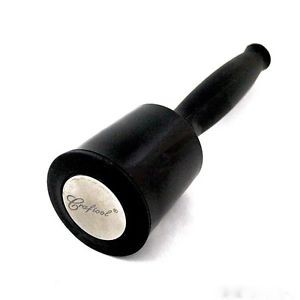
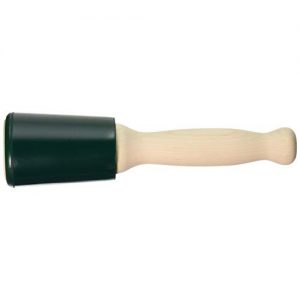
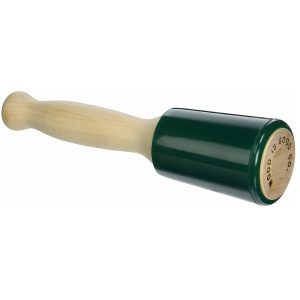
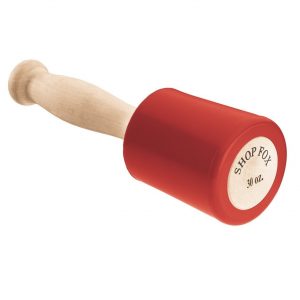
Stamping is an important process of practically any leathercraft project. Only two things are required for good stamping: a print and a special hammer. A good maul is also a must-have thing for making accurate small holes on a leather belt or pelt.
Craft hammers differ from standard household tools. It’s also an appliance for delivering blows to an object. But unlike a regular hammer, a tool for crafting is usually less heavy and more comfortable to use when working with small objects.

Two most common types of hammers for leathercraft are:
- Maul — a heavy instrument with a long handle;
- Mallet — if to compare, usually it’s a heavy wooden block on a convenient handle;
Most tools for hitting rawhide are made of hardwood (like beech) because metal devices may deliver damage to delicate small pieces of rawhide.
Maul vs Mallet: what is the difference?
The opinions differ when it comes to choosing a mauling type for DIY projects. Some hobbyists prefer using a maul device because it’s a shorter tool with a more massive head. It means the instrument won’t deflect on rawhide.
However, other artisans believe that mallets have a larger area to cover when hitting them. Plus, a mallet never rotates when using, especially when fingers are on its head. When a maul is used, it’s necessary to hit right in the center of the head to get the best hit without deflects on a cowhide piece.
It‘s a matter of choice and preference, but mauls are more common picks.
Nevertheless, there are more types of leathercraft hammers than only mauls and mallets. They vary in size, weight, and methods of use. The following review may help to make a final choice.
5. Shop Fox 30-Ounce Non-marring Mallet — the most durable hammer for leathercraft!
 Weighing only 30 oz, this instrument offers a non-marring construction. It’s suitable for multiple activities — punching, stamping, and even riveting. The Shop Fox item can be recommended to everyone who is looking for a reliable and pretty massive hammering tool.
Weighing only 30 oz, this instrument offers a non-marring construction. It’s suitable for multiple activities — punching, stamping, and even riveting. The Shop Fox item can be recommended to everyone who is looking for a reliable and pretty massive hammering tool.
| Pros | Cons |
| Very good weight for any kind of leatherworking; | Unlike most new picks in the set, this one doesn’t have any weird odor; |
| The handle feels well; | After a few weeks of frequent use the handle may fall off; |
| It produces not much noise; | Doesn’t seem different from heavier tools in this segment; |
| It’s possible to use various points of the head; | – |
| A lot of control during meticulous work; | – |
| The head-coating is tough; | – |
This instrument is strongly recommended to everyone who needs a multi-use, sustainable instrument.
4. Wood Is Good 18-Ounce Mallet — the best multifunctional chisel instrument!
 Made in the United States, the Wood is Good product is only 18 ounces. This product can be characterized as a universal tool for simple carving designs. Despite the small size, the mallet is well-balanced and will never hurt fingers — an excellent instrument for riveting works.
Made in the United States, the Wood is Good product is only 18 ounces. This product can be characterized as a universal tool for simple carving designs. Despite the small size, the mallet is well-balanced and will never hurt fingers — an excellent instrument for riveting works.
| Pros | Cons |
| Gentle tapping; | Good only for flat strikes; |
| Great for wood, cowhide and wool punches; | It can be used only for non-food surfaces, not approved by FDA for any food-grade material; |
| The tool doesn’t leave any additional marks on the hitting surface; | A plastic-covered top and wooden handle — may crack easily; |
This is a multi-use leather worker’s hammer. But it’s definitely not the best choice under 30$ due to a cheap handle.
3. Wood Is Good 12-Ounce Mallet — the most lightweight leather craft hammer!
 Another Wood Is Good product with a head that is only 12 ounces. A great pick for people who need small, lightweight mauls for gentle tapping. Hobbyists describe this 12-ounce instrument as an ideal choice for chisels and carving gouges.
Another Wood Is Good product with a head that is only 12 ounces. A great pick for people who need small, lightweight mauls for gentle tapping. Hobbyists describe this 12-ounce instrument as an ideal choice for chisels and carving gouges.
| Pros | Cons |
| The urethane head was designed specifically for absorbing shock; | Polyurethane can be damaged after multiple uses; |
| A great handle grip — suitable for many hours of constant work; | Won’t do for heavy tapping; |
| Can be applied for bookbinding as well as other homemade projects; | Have a large sticker on the head that is hard to pull or remove in any way possible; |
| Without any weird smell, though some urethane instruments can be stinky; | The head has a riddle line that is not smoothed enough; |
| Can last up to 20 years, according to some reviews; | The maple hilt has no additional coating; |
| A very smart design that transfers the power of tapping straight to the chisel, without beating the handle too heavy; | – |
Every hobbyist should consider buying this lightweight appliance for simple or small leatherworking projects.
2. Tandy Leather Craftool Poly Maul — the most expensive mallet that may last for years!
 Tandy Leather tools are great for any hobbyist. A perfect addition to any collection because it is capable of delivering awesome punching and stamping effortlessly. People tend to choose this instrument for everyday projects of any kind because it’s durable, made of top-notch materials and stable.
Tandy Leather tools are great for any hobbyist. A perfect addition to any collection because it is capable of delivering awesome punching and stamping effortlessly. People tend to choose this instrument for everyday projects of any kind because it’s durable, made of top-notch materials and stable.
| Pros | Cons |
| A durable poly head; | The most expensive leather tooling mallet in this review — over 40$; |
| Minimal bounce even when it is used heavily; | – |
| For shock control and less fatigue a handle is contoured; | – |
| Very solid grip; | – |
| Very good brand with awesome instruments; | – |
| May last up to 20-30 years; | – |
A great instrument for working with any rawhide item, though it may seem overpriced.
1. New Wooden Handle Nylon Leathercraft Carving Hammer — the best pick under $15!
 Costing under $15 this appliance is great for any hobbyist. The manufacturer claims it’s the best choice for amateurs and professionals. Hobbyists claim that the best tool for this particular appliance is carving and printing. Though, some believe that it’s too lightweight for constant use.
Costing under $15 this appliance is great for any hobbyist. The manufacturer claims it’s the best choice for amateurs and professionals. Hobbyists claim that the best tool for this particular appliance is carving and printing. Though, some believe that it’s too lightweight for constant use.
| Pros | Cons |
| This nylon item is very solid; | Its wooden handle can easily chip out during the intense tapping; |
| Good for striking small prints and chiseling; | It would be better with a rubber grip because sometimes a finger may slip; |
| The handle is very thick; | – |
| Won’t hurt an arm in the process; | – |
| The most affordable one; | – |
This is easily the best choice among leather working hammers under $15. It’s literally impossible to find a more solid and reliable maul for such price.
Useful Video: Types of Leatherworking Mallets
How to buy a leather craft hammer: tips for customers
To add to a nice and solid craft maul to his leatherworking tools, a hobbyist must think of basics, especially on the terms of a tight budget. It would be more preferable to pick up a top-notch universal appliance for leatherworking projects instead of buying a few different instruments separately for stamping or riveting.
It’s strongly recommended to look for mallets or mauls with such characteristics as:
1. Steel and smooth head
It’s even better is a hammer’s head is made of forged steel. Titanium “face” is a dream but a costly one. Also, pricier models tend to have a smoother face — it’s less likely to deliver any damage to cowhide pieces. Bear in mind that textured heads are prone to leaving marks if you accidentally miss a hitting spot.
2. Curved claw or rip claw heads?
Hobbyists do not need curved claw instruments because they will be required not for prying nails. However, for some small jobs, curved claw tools can be a wise choice. However, most leather working hammers in this category have a flat head.
3. Handle that is comfortable to hold for a long time
Any DIY project demands meticulous and sometimes exhausting job with a solid and convenient instrument in a palm. There are mauls with fiberglass, wooden and steel handles. All materials have their differences.
Fiberglass works great as a vibration absorbent and it’s much lighter than steel. However, they become slippery if not to use special gloves.
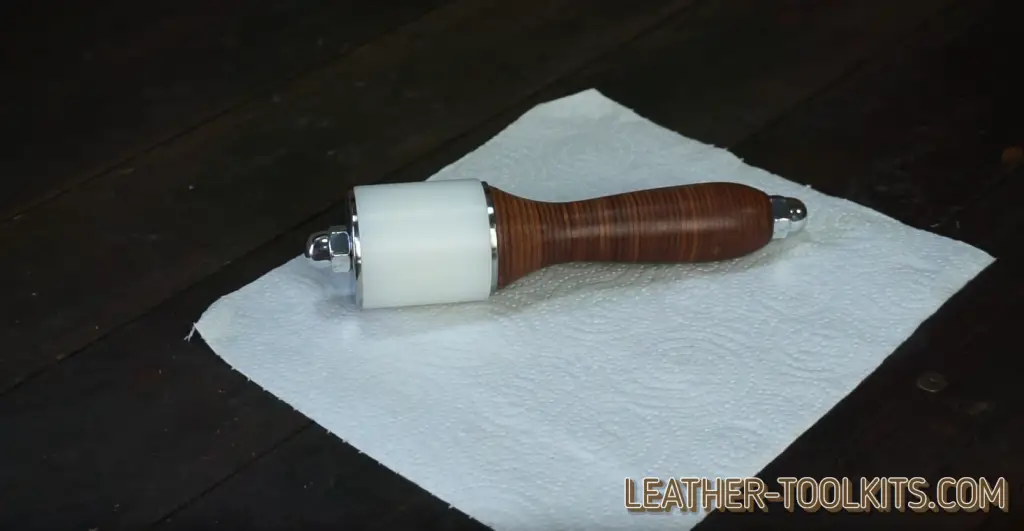
On the other way, steel handles are considered more durable and are good for delivering really powerful blows without much effort. The main drawback — they are the most expensive ones.
Wooden handles are convenient to hold, especially when they are a single piece with the hammer’s head. Besides, mauls with wooden handles are cheaper. The main drawback — such handles may split faster than any other hilt.
Hammer for Leather FAQ
What are the uses of a leather hammer?
A leather mallet, hammer, or maul is a type of hitting instrument used for working with leather pieces and accessories. These tools deliver concentrated force to a place. Often this metal instrument is applied when you need to stamp, mark, or cut the leather during your DIY project.
There are various types of leather hammers, such as tack hammers, small leather hammers, French hammers, saddler’s hammers, etc.
Mallets are available in various weight categories. They determine what weight to use and when it is important. The weights of average mallets range from as little as 2-5 ounces all the way to mallets of 50-60 ounces and sometimes more. The type and weight of a leather mallet you use for a specific task will depend on the necessary force. Setting oblong punches, for example, requires a lot of brute force, so you might need a heavyweight mallet in this case.
All these leather mallets have numerous uses:
1) Good for any DIY projects;
2) For preventing mar on surfaces;
3) For making oblongs (only for solid mallets);
4) For fixing/setting snaps, rivets, eyelets;
5) Good for stamping;
6) For patting down folds and seams;
7) For punching holes;
8) For lacing;
Besides, a leather hammer can be used for setting rivets, hitting tacking shoe nails, hitting the glued surfaces and tapping a seam flat.
Who makes the best leather-working hammers?
A few brands make some of the best leather-working hammers:
- Tekton;
- Barry King;
- Aiber;
- C.S. Osborne;
- Tandy Leather;
- Shop Fox;
What is a cobbler’s hammer?
A cobbler’s hammer is a tool used by shoemakers. Tiny tacks and nails are used in shoemaking to attach the leather uppers to the soles. Cobbler’s hammers are used by shoemakers to attach these tiny pieces. But they can also be used for a variety of other purposes.
What leather tools you may need for leatherworking?
Leatherworking can grow with you. It is one of the advantages of selecting leathercraft as a hobby. Initial DIY projects can be simple, needing only a few basic skills and resources. Similarly, a large investment in very precise leatherworking tools is not needed.
Here is the list of basic leather tools for the entry-level jobs:
1) Threads and needles
A needle and thread picked to stitch leather. Perhaps it is one of the most basic tools required. The needle and thread applied for an embroidery project or a standard sewing craft, obviously, will not be a good option for any leather job. You should invest in a heavyweight needle to stitch through the leather. It should be durable enough. Also, you should select lacing or waxed thread specially designed for leather to achieve the best results.
2) Cutting board and a sharp knife
A sharp knife or cutting utensil is another basic item that you can’t live without. Again, standard crafting scissors should be skipped. They really aren’t heavy-duty enough to give a natural leather piece a smooth cut. It is important that you still have some sharpened knife or cutting utensil. A dull knife is not going to be powerful and can be risky, too. It may slip, leading to a wound rather than a leather cut on your leather piece. You’ll still want to make sure you have the right surface from which to cut by using a knife.
3) Spacer, beveler and groover
Though not strictly required, leather groovers, spacers and bevelers will do a great deal to provide a more professional look to your leatherwork. Groovers are picked in a straight line to create a groove in the leather. This line indicates where to put the stitches for seams. For calculating an even gap between the actual stitches, spacers may then be used. You can create tidy and pleasing stitches without much hassle until the positions for the stitches are labeled. A beveler is another useful instrument (though it can’t be called a basic instrument). You will round off the rough edges of any piece of leather with a beveler. This tool may give a more polished look to your leather project.
4) Stitching clam/pony
Although these may look like they belong on a farm or at the beach, simple leatherworking instruments are really a stitching pony or a stitching clam. These methods are used, close to a vice or a clip, to hold the leather project in place. It is not important to have a stitching pony or clam, but these tools will make any leather project simpler. They will be the difference between an unmanageable project and a fun project by also managing your project.
How to use a tack hammer?
A lightweight hammer typically picked to secure upholstery cloth to furniture frames using tacks or tiny nails is called an upholstery hammer (a.k.a. a tack hammer). Most types have two faces, with one face normally magnetized to better position tacks. Usually, its face has a split surface to make the magnetic hold stronger.
What are the oz hammers?
Classic leather hammers are distinguished by the head weight:
- 16 – 20 ounces for DIY projects;
- Less than 16 ounces – such hammers can be used for trimming jobs;
- Over than 20 ounces – such tools can be recommended for framing and destruction;
A smooth face could be a good choice for DIYers and general pro use since it will not mar surfaces. You need more heads to get more hits-it sounds simple. However, a heavier hammer, at least as far as framing hammers are not always necessary and can be even considered as melee weapons. Since speed contributes more to the energy impact than mass, lightweight hammers are more preferable by DIYers and craftsmen.
How is a small hammer called?
Typically, such hammers are called tack hammers. These are very small, really lightweight instruments. These hammer types are meant for the driving of tiny, fragile nails. These hammers may also be referred to as upholstery hammers and have been developed to attach fabrics to furniture. To aid the position for attached tiny nails and tacks, it also has a magnetic end.
Conclusion
Any mentioned instrument can become the perfect leather tooling maul. Despite the cost, all tools are made of durable materials and have a sophisticated design — the great picks for any hobbyist’s collection. Just use them with a steady hand and solid purpose.


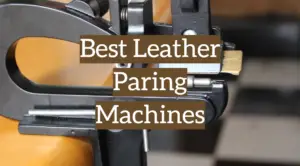

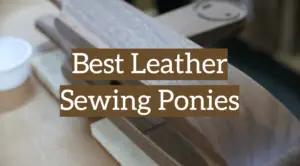

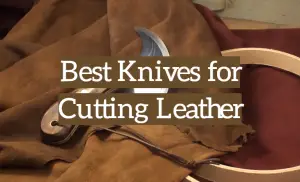
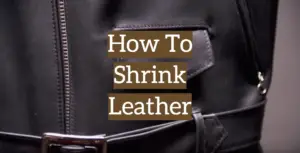
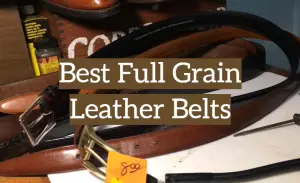







I use a traditional hammer for stamping leather, but need to invest in something more suited for leather specifically. Handle grip and weight are particularly important to me, and this article seems to have a good collection of options so one can find the best hammer for leather. The “tips of customers” section here is really helpful. Thanks!
Hello. Sam! Thanks for your comment.
I just have too many hammers for leather! A good leather hammer is easy to find, but then you always seem to be adding new ones to your collection. My favorite has a durable poly head and gel grip on the handle. I can really go to town on leather for any project with it.
It’s definitely not surprising that the Tandy leather hammer is overpriced! It seems like everything from Tandy is expensive. I was a little bit surprised that in spite of that you rated it highly, I guess it’s expensive, but worth the money, lol. Still, I’m going to try the nylon and wood leather hammer that you listed after that. I just wish they made one in all black like Tandy, but I guess that’s just aesthetics. maybe if it doesn’t hold up through this year’s projects I’ll give in and go back to Tandy leather products
I had a Shop Fox 30-ounce mallet and it was good while it lasted but as you also specified, at some point the handle will fall off. That’s what happened in my case, after a few months. Did I get my money’s worth? Yes, I think I did but I wanted something better so I went for the Tandy Leather Craftool Poly maul. It’s much better, should last 10+ years, has a very good grip and has more power than what I had before. Is it expensive? If it lasts me over 10 years, it’s not.
The Shop Fox 30-ounce non-marring mallet is one of the best hammers for leather I’ve tested out. Is it the very best? I don’t know. I’ve heard people saying the handle sometimes falls off but my experience has been a positive one for the time being.